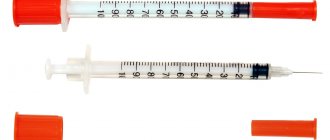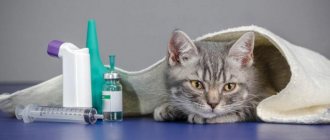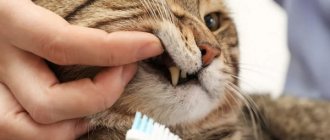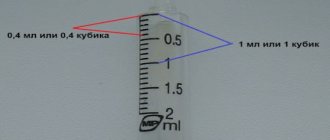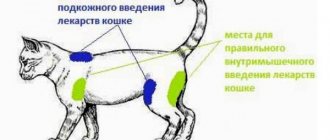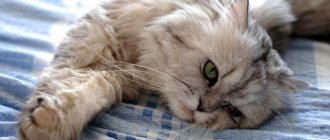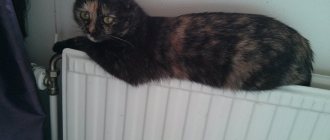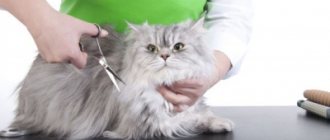If the pet is seriously ill, the loving owner has to learn how to give injections to the cat in the withers or muscles. Even without medical skills, this manipulation is not difficult to master. The main thing is to cast aside all fears. In addition, this will speed up the animal’s recovery process and save the family’s expenses (no need to take the cat to the veterinarian several times a day or pay for a day hospital stay).
Let's find out which injections you can do yourself, and in which cases only a veterinarian performs the manipulations.
General rules
Often, the veterinarian prescribes a course of parenteral injections for the cat, which are placed subcutaneously (in the withers area), in the thigh muscle or shoulder. In order to inject a cat correctly and without consequences (in the withers area or muscle), it is important to know a few rules:
- Only a warm solution can be administered (this is especially true for vaccines and drugs that are stored in the refrigerator). The medicine should be at approximately room temperature. This can be achieved if you take out the bottle in advance (2-3 hours before the procedure) or warm it in warm water. If this rule is neglected and a cold solution is introduced, there is a high probability of the formation of difficult-to-absorbable infiltrates.
- It is necessary to prepare several spare syringes. Often you have to draw liquid from a bottle with an aluminum cap, and this leads to the formation of nicks on the needle, which causes additional pain for the cat when administering the medicine. If the solution was pre-mixed, viscous or poorly dissolved, the needle cavity becomes clogged. In such cases, it is recommended to draw the drug into the syringe with one needle, then replace it with a new one.
- Always expel the air from the syringe cavity before injecting. Otherwise, there is a risk of a bump or bruise. This offense will not bring a mortal threat, but will complicate further injections.
To remove air bubbles, use a finger on the body of the syringe or rotating movements to collect all the small bubbles into one large one and then remove it.
Syringes are different and sometimes it is extremely difficult to remove all the bubbles. In this case, when injecting the solution, it is necessary to hold the syringe piston vertically upward (the medicine will leave, but the air will remain in the syringe).
- Carefully read the instructions for the prescribed drugs, especially if you need to combine several components (for example, when vaccinating or creating complex solutions). In such processes, mixing sequence is important for optimal dissolution.
If the doctor prescribed several injections in one period of time, then it is worth checking about the possibility of combining solutions together. If this is contraindicated, then it is necessary to inject with a short time interval.
- Change injection sites if you have to do them frequently. Subcutaneous injections can be given to the cat at the withers (scruff), in the area of the shoulder blades or groin. The withers are the highest point of the body and are located on the spine between the cat's shoulder blades. Moreover, the skin on the withers is much thicker and more difficult to pierce with an insulin syringe than that above the shoulder blades.
Intramuscular injections are given to cats in both the hind (pelvic) and fore (thoracic) limbs.
- Determine on your own the method of administering the medication, based on the volume or dose (this only applies to those medications that can be administered by any parenteral route, bypassing the gastrointestinal tract). Large volumes of medications (over 3-5 ml) are good to inject into the cat’s withers (the skin stretches well and the likelihood of bumps forming is reduced). Solutions in a volume of up to 3 ml can be safely injected into the paw, and their effect will appear a little faster.
For example, the doctor prescribed 3 ml injections to the cat in the withers area or muscle (the injection point is at the discretion of the owner). Injecting the drug subcutaneously will be less painful for the pet.
Important to remember! Air bubbles occupy a certain volume, which leads to an error in dosing the product. This should be taken into account when administering small doses of potent medications.
Choosing the right syringe and needle
When choosing a syringe, two factors are important: the size of the cat (weight, age) and the consistency of the injected drug. The larger and thicker the pet, the longer the needle should be. Accordingly, 2-10 ml syringes are suitable for adult and well-fed cats.
Smaller syringes (1 ml) can be used to inject cats intramuscularly into the thigh, but the medicine should not be thick.
For kittens and malnourished animals, 1 and 2 ml syringes are optimal.
Important! It is not recommended to place a needle from a larger syringe on an insulin syringe, or vice versa (the needle may fly off while pressing the piston).
Changing the needle to a thinner one is allowed in cases where the cat is indicated for subcutaneous injection of 10-20 ml of liquid or more. For this manipulation, it is better to draw the medicine into a large syringe and then change the needle.
Important! The cat should be given an injection with a disposable and sterile syringe. Do not use the same instrument twice to avoid clogging the needle and mixing different drugs.
Do I need to treat my skin with an antiseptic?
Antiseptic treatment of the injection site in cats with fur is useless. Manipulation makes sense only for hairless cat breeds (Sphynx, Elf, Bambino, Cojona, Peterbald, Ukrainian Levkoy).
Needle insertion depth
The most important thing in the process of giving an injection to a cat is to deliver the medicine strictly according to indications. When injected into the withers area - under the skin, and when injected intramuscularly - into the muscle. Therefore, a novice “doctor” should practice on a chicken carcass.
The injection into the cat's withers is made no deeper than 1-1.5 cm. If you overdo it, you can pierce the skin fold completely, which will be visually noticeable by the trickle of medicine flowing out or the fur around it getting wet. The angle of needle insertion when injecting under the skin should be 45 degrees.
The depth of intramuscular injection is determined taking into account the size of the animal’s paw and the length of the needle. Approximately the needle is inserted half or 2/3. You should not insert the needle completely, it may break and go into the thickness of the muscle fibers. The correct angle of the syringe is 90 degrees to the surface of the skin.
Attention! The manipulation must be carried out confidently and quickly, as the cat experiences pain. She will loudly express dissatisfaction and try to escape by any means. Therefore, veterinarians advise that before injections, be sure to trim the claws and securely restrain even a very calm cat.
Speed of drug administration
Descriptions of medications sometimes indicate the rate of administration (especially if the drug is viscous or viscous).
Correct fixation
To securely hold a cat, the following are suitable:
- a fixing bag is an excellent and useful invention for obstinate animals, it allows for various manipulations (injections in the withers and legs, trimming claws, examining the mouth) and will protect a person from the sharp claws and teeth of a cat;
- a thick blanket or towel in which to swaddle the cat;
- a strong assistant who needs to grab the animal’s front paws with one hand and the hind paws with the other.
If the pet is calm or in a depressed state, then it will be quite enough to place the cat on four paws on the floor or table, ask an assistant to hold it by the withers and hind leg until the procedure is completed.
Preparation for the procedure
The most important thing is sterility, because you don’t want to harm your pet even more with your injection.
- Wash your hands thoroughly with soap. After this, open the sterile syringe. Be sure to take a new one with each injection, otherwise you risk introducing infection into the wound.
- If the ampoule has been opened previously, its contents cannot be used. Don't put your cat's health at risk.
- Make sure you take the exact medicine you need.
- Open the ampoule.
- Take the drug.
- Expel the air from the syringe. To do this, holding it up with the needle, slowly press the plunger until the first drop of medicine appears.
Subcutaneous injection technique
After fixing the cat and preparing the syringe, you need to do the following:
- With two fingers, form a large fold of skin in the area of the withers or near the shoulder blade;
- gently pull it back and hold it;
- insert the needle at the base of the skin at an angle of 45° until you feel “falling into the void”, approximately half the length;
- introduce the medicine smoothly;
- remove the needle;
- straighten the skin of the withers;
- give a light massage.
When an injection is placed at the withers of a kitten, the needle must be inserted carefully and shallowly, otherwise it can get into the neck muscles. When properly injected into the subcutaneous space, the liquid will easily come out of the syringe, forming a soft ball that will dissolve in a few minutes.
An aggressive or fearful cat should receive a subcutaneous injection only after checking its veterinary passport for the presence of a rabies vaccination stamp. Because through cat bites, a person can become infected with this dangerous virus.
What is widow's hump
Sometimes it seems that nature wants to complicate the completely natural process of aging as much as possible. This is especially true when it comes to the occurrence of widow's hump. This is a non-medical term for the slouching behavior of many older people, especially women. Although this is a fairly pronounced external defect, in many cases this condition, which manifests itself in the upper back, can be prevented or corrected. To understand how to properly and safely remove a widow’s hump on the neck, you need to know how and where this problem comes from.
How to give an intramuscular injection to a cat
Intramuscular injection is another type of parenteral administration of complex solutions (emulsions, suspensions), when the drug penetrates directly into the muscle.
Cats are given intramuscular injections in the back of the thigh and shoulder. For adult cats, the maximum dose is 2 ml; for kittens, the dosage is half as much.
Algorithm of actions for making an injection into a muscle:
- immobilize the cat;
- prepare a syringe;
- straighten the limb, try to relax the cat;
- feel the muscle roll and quickly insert the needle at an angle of 90°, approximately 2/3 of the length;
- gently press the syringe plunger and squeeze out the contents;
- remove the needle and lightly massage the limb.
Important! The manipulation must be done as quickly as possible so that the animal does not experience stress. It will be useful to pet the cat after the injection and treat it with its favorite treat.
How to remove widow's hump on the back: surgical techniques
For men and women who are bothered by a dowager's hump or withers, a plastic surgeon can help. The contour of the upper back can be corrected through liposuction or surgery. Before starting treatment, the doctor will determine how to most effectively and safely break the widow’s hump:
- remove widow's hump with lipolytics;
- perform an operation;
- remove widow's hump with laser lipolysis.
Using specialized liposuction techniques, the surgeon can significantly reduce or remove problematic fat and fibrous tissue to create a slimmer, desired aesthetic with a natural-looking result.
In addition to creating a more aesthetically pleasing contour of the upper back and lower neck, surgical removal of the widow's hump is helpful in relieving the neck and back discomfort often associated with this condition. In addition, full neck mobility can also be restored in patients with limited neck movement caused by excess fatty and fibrous tissue. When the fat pad extends from the jawline to the front of the neck, surgical fat removal and/or tissue excision techniques can smooth and restructure the affected areas so they appear slimmer.
Possible mistakes and how to avoid them
Sometimes after giving injections to cats at home, complications arise that arise due to typical mistakes made by beginners:
| Consequences of injections in the withers | Cause | What to do |
| The lump does not go away for a long time (infiltration or abscess) | A drug with an irritating effect was introduced, which is prohibited from being injected under the skin | Contact a veterinarian, he will take a puncture of exudate and prescribe treatment |
| Hair thinning, alopecia | Increased sensitivity of the cat to frequent procedures, stress, possible allergic reaction | Consult a veterinarian |
| Lipodystrophy (formation of pits in the skin at the sites of hormonal injections) | With frequent administration of hormonal drugs (Insulin, Covinan), the active substances destroy adipose tissue at the injection site | Alternate injection points |
| Consequences of intramuscular injection | ||
| Bruise | Air in the syringe that has entered the capillary and caused it to clog. Or the capillary was damaged and minor bleeding occurred | There will be no threat to the animal’s health, but the next injection will have to be given in the other leg |
| Lameness after injection | The medicine was injected close to the inner surface of the thigh (the needle was inserted deeply), where the nerves pass. The resulting muscle soreness is expressed by temporary lameness of the cat | This is not dangerous and will go away after a day. You can do a little massage |
| Tissue necrosis | A drug used that is infused only intravenously | Contact a veterinary clinic |
| Tissue suppuration, phlegmon | Frequent injections in the same place, especially with thick and viscous (oily) drugs | Contact a veterinary clinic |
| Hair loss around the injection site, redness of the skin | Allergic reaction, individual intolerance to the components of the drug | Stop injections and contact your doctor to review treatment |
The most unfavorable consequence of unskilled home injections is the needle breaking and penetration into the tissue. This happens when the cat moves suddenly when the needle tip is inserted. It is almost impossible to remove it yourself. The animal will experience severe pain with any movement. Therefore, if this happens, you need to urgently consult a doctor. In this case, an x-ray and surgery will be required.
How to get rid of widow's hump on the back: non-surgical methods
When discussing how to correct a widow's hump with your doctor, it is important to keep certain guidelines in mind.
Increase your calcium intake: Most postmenopausal women should increase their daily calcium intake to 1,800 milligrams per day. Be sure to check with your doctor to make sure this dosage is safe and compatible with other medications.
- Regular physical activity. We have already discussed how to get rid of widow's hump through exercise. But weight-bearing exercises for the whole body, back muscles, buttocks, arms and legs, such as strength training, are also important. They can help increase bone density over time. Exercising, stretching and yoga can also help develop good posture and body alignment, as well as increase flexibility.
- Healthy Diet: Patients may benefit from a diet that is rich in fruits and vegetables. You should also avoid carbonated drinks, which can negatively impact your bone density due to the phosphoric acid found in some varieties. Some doctors also believe that caffeine can make bones porous.
- Correct your posture: Always be aware of your posture. Try not to push your head forward or slouch your shoulders, even when you're sitting at your keyboard or watching TV on the couch. Taping the widow's hump can help maintain posture and reinforce the correct posture. This is the application of special elastic bands that relieve muscles and support posture.
The question also often arises of how to remove a widow’s hump with a massage. Carrying out a course of massage helps to strengthen metabolic processes, relax muscle spasms that affect posture, and stimulate the breakdown of excess fat.
How to cure widow's hump with liposuction
For most patients with withers, neck liposuction is the most suitable technique to achieve an ideal result. Typically, neck liposuction can only be performed under local anesthesia, which reduces the likelihood of possible complications from general anesthesia. However, for some patients, the doctor may decide to use general anesthesia. Liposuction cannula can be inserted through very small incisions, which leave minimal residual scarring after the healing process is complete.
In some cases, the doctor may perform a second liposuction procedure at a later date to improve results and achieve an optimal appearance. Because the skin on the upper back/neck is quite thick and the fat can be quite fibrous, the surgeon uses special lipocannulas to improve the shape, define the area, and facilitate shrinkage of the skin. Although there are some doctors who may use an “open technique,” many plastic surgeons prefer to approach the area in a minimally invasive manner to avoid scarring.
Recovery depends on the technique used during surgery. Liposuction patients usually recover quickly and can return to their normal activities in about a week after surgery. Sometimes drainage may be required for proper healing. After full plastic surgery, a longer stay in the clinic and a long recovery period may be required.
